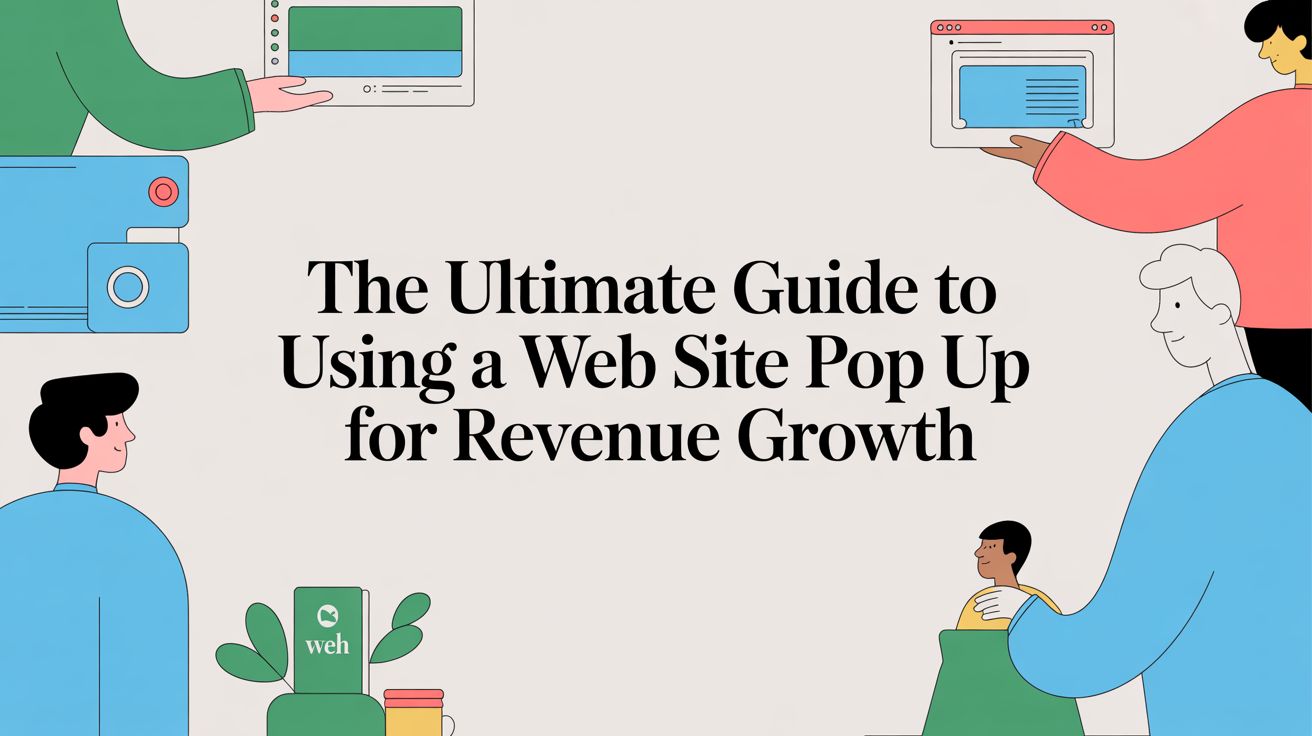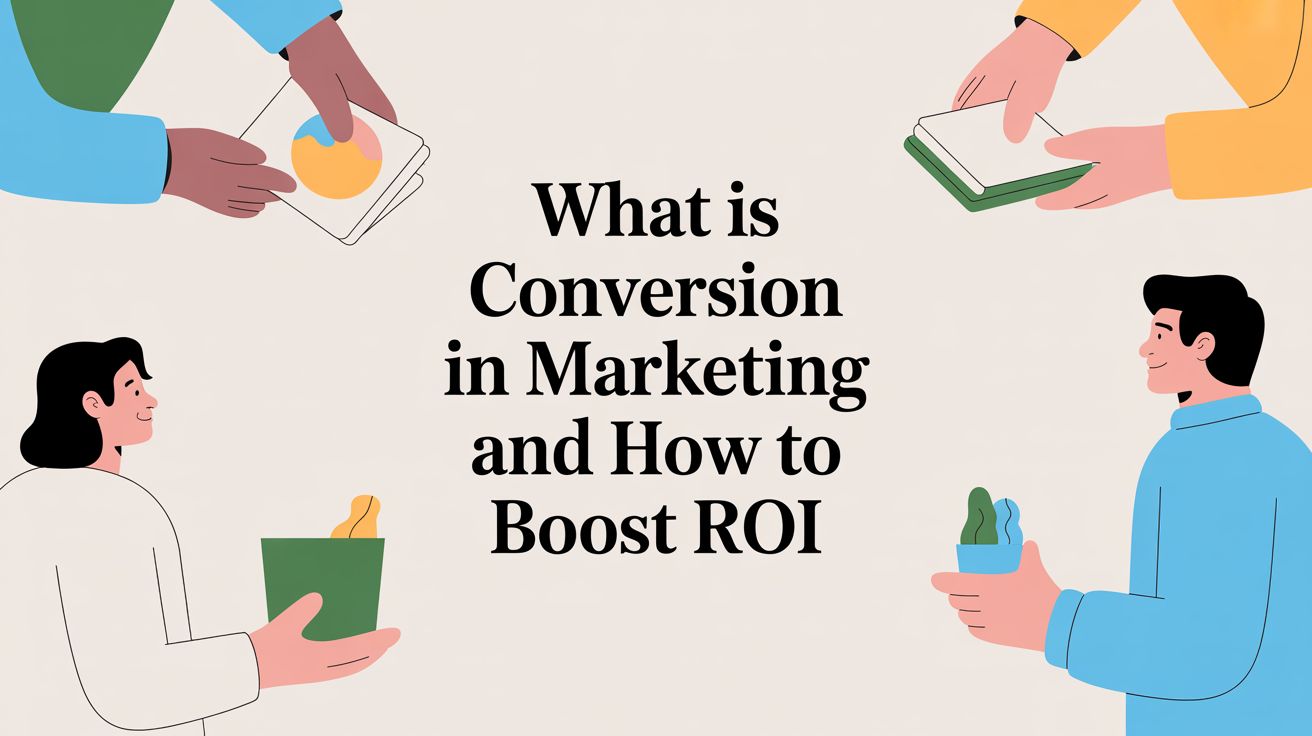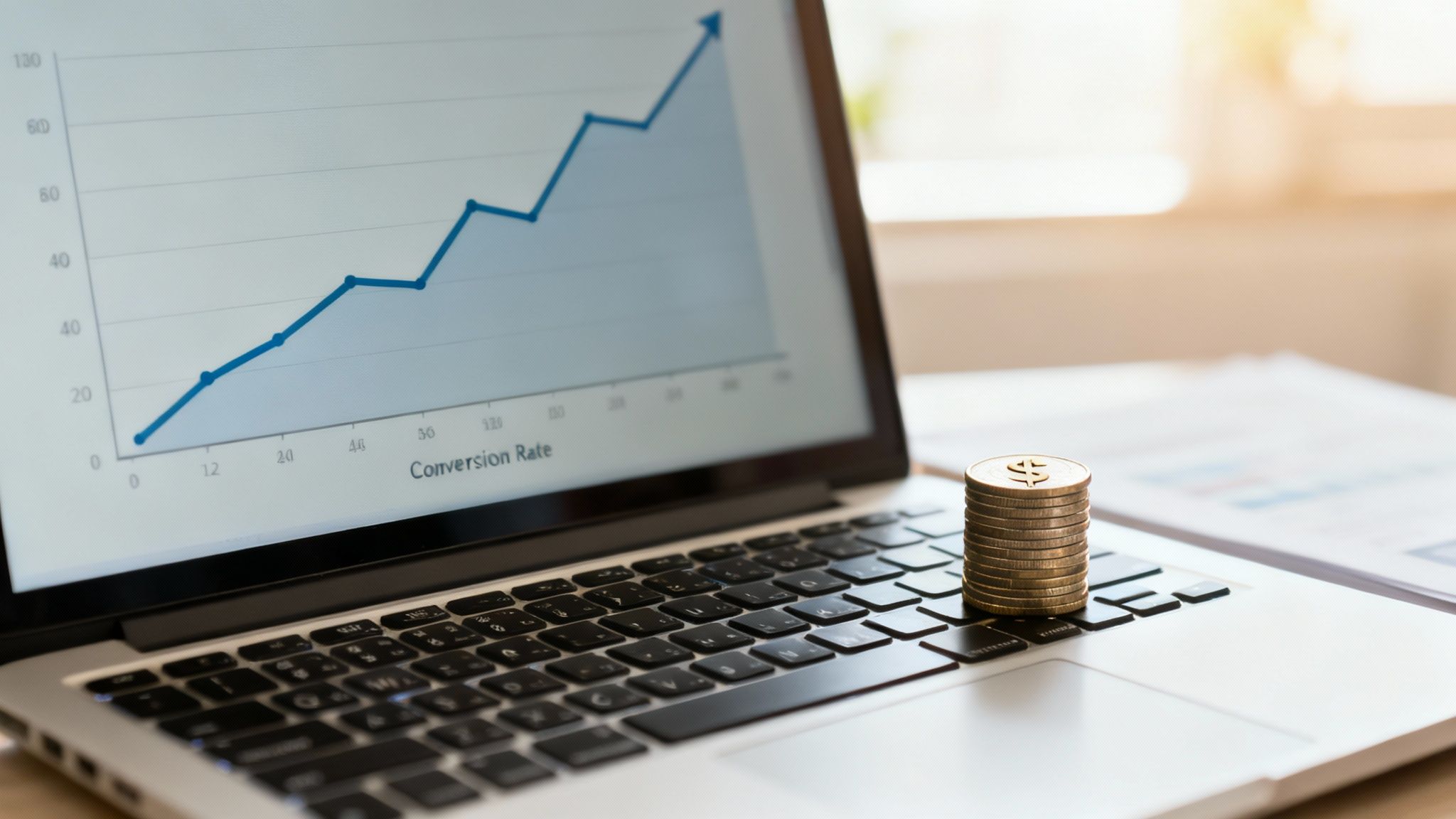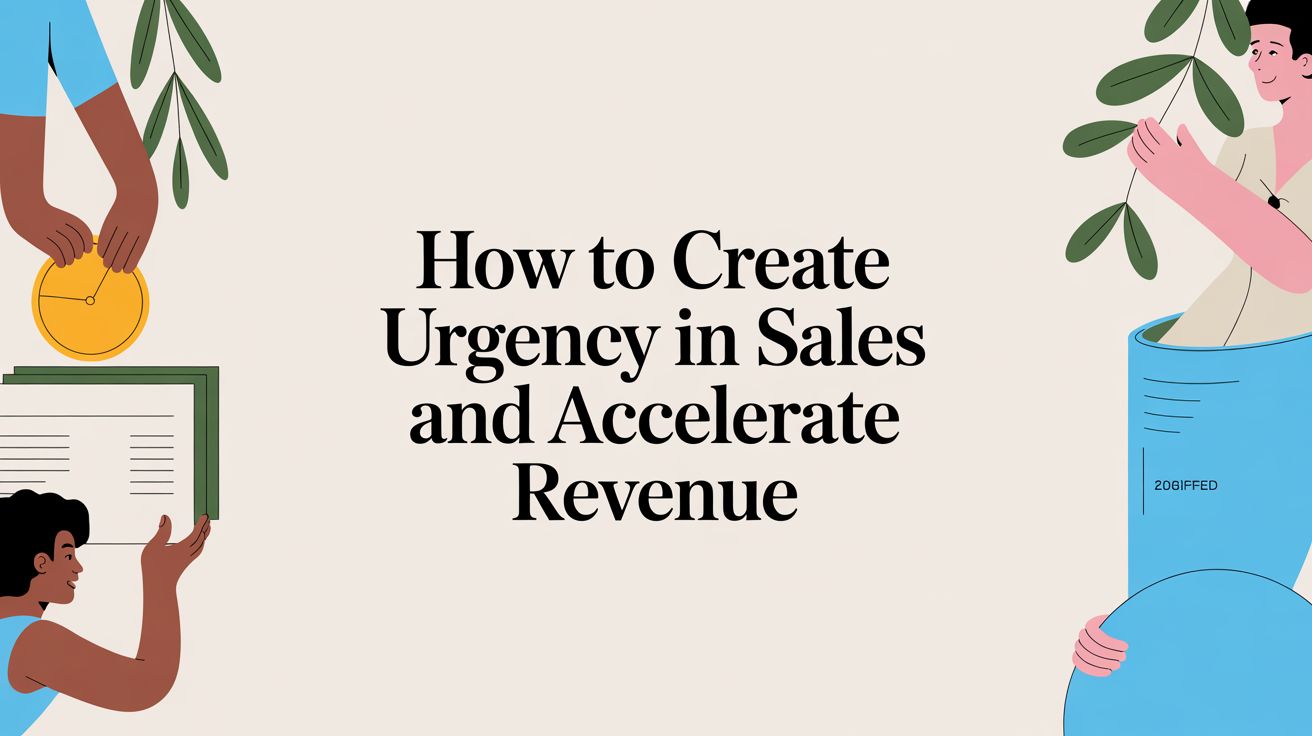
What Is Conversion In Marketing and How To Boost ROI

In marketing, a conversion is the pivotal moment a website visitor completes a specific, desired action.
It’s the point where a passive browser becomes an active participant in their journey with your brand. This single action is what transforms your marketing efforts—from ad spend to content creation—into measurable, predictable revenue, making it the most critical metric for business impact.
What A Conversion Really Is

A conversion isn't just a click or a page view—it's the tangible result of your marketing strategy connecting with consumer psychology. It's the point where a potential customer shifts from consideration to action, directly impacting your bottom line and return on investment (ROI).
However, not all conversions carry the same financial weight. Understanding the difference is the secret to building a sales funnel that reliably generates revenue.
To fully grasp what conversion in marketing means for business growth, you must distinguish between the two primary types.
Macro vs. Micro Conversions Explained
This table breaks down the two primary types of marketing conversions with clear examples to help you identify and optimize them within your own business.
| Conversion Type | Definition | Business Impact | Example |
|---|---|---|---|
| Macro | The ultimate business goal. The primary action you want users to take that directly ties to revenue. | High. These are the actions that directly generate revenue and determine profitability. | Making a purchase, requesting a quote, or starting a paid subscription. |
| Micro | Smaller, incremental actions that signal purchase intent and move a user closer to the primary goal. | Indirect but crucial. These actions build trust and guide users toward the macro-conversion. | Signing up for a newsletter, adding an item to the cart, or watching a product video. |
In short, macro-conversions are the finish line. A completed purchase on a Shopify store is the classic macro-conversion that drives revenue.
Micro-conversions are the behavioral breadcrumbs a user leaves along the path, signaling they’re getting closer to that finish line. They build engagement and pave the way for the ultimate sale.
A micro-conversion, like an email signup or adding an item to a cart, is a vital signal of purchase intent. Optimizing for these smaller commitments is essential for guiding users through all 5 stages of the consumer journey.
For instance, when a visitor adds a product to their cart, that's a powerful micro-conversion. No money has changed hands yet, but they've taken a critical psychological step, signaling strong intent to buy.
It’s all connected. Reports on sales call conversion rates show that different channels perform differently. Referrals lead the pack at 25.56% and email marketing isn't far behind at 22.83%. This demonstrates how various touchpoints and micro-actions all contribute to that final, revenue-generating outcome.
Why Conversions Are Your Most Important Metric

It’s easy to get caught up chasing website traffic. While visitor numbers feel like a win, seasoned marketers know the true story of profitability is told by conversions. A small increase in your conversion rate will almost always deliver a greater impact on your ROI than a costly surge in new visitors.
Why? Because a conversion is where marketing investment meets financial return. It’s the moment a browser becomes a buyer, a lead, or a subscriber.
When you focus on conversions, you're maximizing the value of every dollar you've already spent on acquisition. Instead of just pouring more money into getting clicks, you’re turning the audience you already have into revenue. This is how you protect profit margins and ensure your ad spend isn’t just evaporating on visitors who never take action.
The Direct Impact on Business Growth
Sustainable growth doesn’t come from having the most website visitors; it comes from having the most customers. When you get serious about conversion rate optimization (CRO), it creates a positive ripple effect, leading to smarter financial and operational decisions across your entire business.
- Sky-High ROAS: Let’s say you double your conversion rate from an industry average of 2% to 4%. You’ve just effectively cut your customer acquisition cost (CAC) in half. That’s an instant, massive boost to your Return on Ad Spend.
- Smarter Inventory Management: A predictable conversion rate makes sales forecasting more accurate. You can stop guessing, preventing the profit-killing mistakes of overstocking or running out of a popular item, which is especially critical for Shopify merchants.
- Higher Customer Lifetime Value: When you create an experience that smoothly guides someone to their first purchase, you're setting the stage for a long-term relationship. This makes it far easier to bring them back for future sales, building real customer lifetime value (CLV).
While conversions are the lifeblood of direct response, they aren't the only thing that matters. To get a complete picture of your brand's health, it’s worth understanding where you stand in the broader market. Learning how to calculate Share of Voice is a great way to see how you stack up against the competition.
Ultimately, a high conversion rate is a sign of a healthy, efficient business. It indicates you understand your customer's needs and have successfully removed the friction between their intent and their action.
When you truly grasp what pushes people to act, you can build a more resilient and profitable operation. To dig deeper, you can learn more about how to measure marketing campaign effectiveness and get the full picture.
How To Set Realistic Conversion Rate Goals
Every marketer eventually asks, "So, what's a good conversion rate?" The honest answer? There is no single magic number.
A "good" rate is a moving target, completely dependent on your industry, traffic channel, product price point, and sales complexity. Applying a one-size-fits-all number is a recipe for disappointment because it ignores the specific context that shapes consumer behavior.
Benchmarking Against Your Industry
The smartest way to set achievable goals is to analyze what's normal for your specific industry. These benchmarks provide a realistic starting line and allow you to measure your performance against direct competitors, not some irrelevant average.
A report from Unbounce reveals just how different these numbers can be. A SaaS company might be thrilled with a 3.8% median conversion rate because their sales cycle is long and requires demos and team buy-in. Conversely, the legal sector can see rates as high as 12.3%—people with legal issues are typically highly motivated and need an immediate solution.
This data highlights a core principle of behavioral economics: the more trust and consideration a purchase requires, the lower the conversion rate tends to be.
Factors That Influence Your Goals
Beyond industry-wide benchmarks, several other factors will shape what a realistic goal looks like for your business.
- Traffic Source: A user who actively searched for your brand on Google has much higher purchase intent than someone who idly clicked a social media ad. They require different conversion goals and experiences.
- Price Point: A $20 t-shirt is often an impulse buy. A $2,000 piece of equipment is a major decision that requires multiple touchpoints and more consideration, naturally leading to a lower conversion rate.
- Device Type: Mobile and desktop conversion rates are rarely identical. With global cart abandonment rates hovering near 70%, a clunky or confusing mobile checkout experience can demolish your conversion potential.
A realistic conversion goal is a dynamic target. It should be based on your specific industry benchmarks, historical data, and the unique context of each marketing channel.
Ultimately, setting the right goals comes down to knowing your data and understanding the consumer psychology behind it. When you analyze these variables, you can stop chasing vague industry averages and start making strategic moves that measurably improve your own performance. For a deeper look at what you should be tracking, check out our guide on essential sales performance metrics dashboards.
The Psychology Behind High-Converting Experiences
Understanding what conversion means in marketing goes far beyond tracking clicks and analyzing data. The highest-converting experiences are built on a solid foundation of human psychology. To move the needle on revenue, you must leverage the behavioral principles that guide a person’s decision to buy.
At its core, a conversion happens when you align your offer with a customer's intrinsic motivations. This isn't about manipulation; it's about making the choice to purchase feel natural, intuitive, and beneficial for the shopper. This is the science of urgency marketing.
Tapping into Proven Behavioral Triggers
A few key psychological concepts from behavioral economics consistently compel people to act. When used ethically, they don't just ask for a sale—they create a powerful, justifiable reason for a customer to act now.
- Scarcity: We place a higher value on things we perceive as rare. A "limited stock" notice or access to an exclusive product drop triggers the fear of missing out (FOMO), a powerful motivator for immediate action.
- Social Proof: As social creatures, we look to others for cues on how to behave. Displaying customer reviews, testimonials, and user-generated content builds trust and validates the decision to buy.
- Anticipation & Urgency: Deadlines create action. However, advanced urgency marketing moves beyond basic countdown timers. It connects urgency to specific user behaviors, enhancing the customer journey rather than interrupting it and building anticipation for a positive outcome.
This chart shows how conversion rates swing between industries, giving a glimpse into the different psychological journeys in fields like SaaS versus legal services.
The data shows that high-intent fields like legal services tend to convert better because the user's need is already urgent. They aren't just browsing; they have a pressing problem to solve, demonstrating the power of inherent urgency.
A simple countdown timer tells a user that time is running out. In contrast, a behavior-triggered urgency campaign from a platform like Quikly responds to a user's unique actions, making the message personal, relevant, and far more persuasive. It’s the difference between shouting at a crowd and having a strategic one-on-one conversation.
For merchants on a platform like Shopify Plus, weaving these psychological triggers into the shopping experience—from banners to popups—is a game-changer. By automating "urgency moments" that respond to user actions (like adding to a cart), you can drive immediate revenue and move inventory efficiently, protecting profit margins. This approach is far more sophisticated than basic pop-ups designed only for email capture.
Proven Strategies to Up Your Conversion Game
Knowing the psychology of why people convert is one thing; implementing it to drive revenue is another. That's where Conversion Rate Optimization (CRO) comes in—the systematic process of turning psychological insights into tangible business results. It involves methodically testing and improving every customer touchpoint to remove friction and guide users toward the final conversion.
The goal isn't just to make minor adjustments. It's about building a seamless path from discovery to purchase. For Shopify store owners, this means scrutinizing everything from product page layouts to the final click in the checkout. A slow-loading site or a confusing form can easily be the difference between a sale and another abandoned cart—a problem that plagues nearly 70% of all online shopping sessions.
Actionable CRO Tactics You Can Use Today
You don't need a huge budget to start seeing a difference. Begin by focusing on high-impact areas where small changes deliver big results.
- A/B Test Your Headlines and CTAs: Your headline is the first thing a visitor reads, and your call-to-action (CTA) is the final prompt before conversion. Continuously test different versions to discover which words and phrases resonate most with your audience and drive action.
- Streamline Your Checkout Process: Every extra field is another opportunity for a potential customer to leave. Simplify your forms, offer guest checkout, and provide multiple payment options to make buying from you as effortless as possible.
- Prioritize Site Speed: A one-second delay in page load time can reduce conversions by up to 7%. Compressing images and using reliable hosting are quick wins with a direct impact on your revenue.
Weaving Urgency into Your Tech Stack
For Shopify Plus merchants, the real magic happens when you integrate these CRO strategies with your existing marketing tools. When you connect an advanced urgency platform with your ESP, like Klaviyo, or your SMS marketing platform, you can build powerful, automated campaigns that react to customer behavior in real-time.
Imagine this: instead of a generic cart abandonment email, you trigger a personalized, time-sensitive offer that speaks directly to that user's hesitation. A simple reminder becomes a powerful psychological nudge to complete the purchase now.
These integrations turn passive data into proactive, revenue-driving action. The numbers prove it works. The average conversion rate for Google Ads has climbed to 6.96%, and some industries, like automotive repair, see rates as high as 14.67%. For a deeper look at how to put this into practice, you can explore how to make timers that boost conversions by tapping into these psychological triggers. This shows that targeted, well-timed messages are absolutely essential for capturing high-intent traffic.
Frequently Asked Questions
Still have a few questions about what conversion really means for your marketing? Let's clear up some of the most common ones.
What Is a Good Conversion Rate in Marketing?
A “good” conversion rate is relative and dynamic. The right number for you depends on your industry, traffic source, and the specific action you’re measuring.
While the eCommerce average of 2.5% is often cited, it's just a starting point. This benchmark pales in comparison to high-intent channels like Google search ads, where rates can be significantly higher. The smartest approach is to benchmark your performance against your industry's averages and, more importantly, focus on continuously improving your own historical numbers. Outperforming your previous record is how you achieve sustainable growth.
How Do You Calculate Conversion Rate?
Calculating your conversion rate is refreshingly simple. Use this straightforward formula:
(Number of Conversions / Total Number of Visitors) x 100 = Conversion Rate
For example, if 10,000 unique visitors landed on your product page last month and you generated 250 sales, your conversion rate would be 2.5%. The key to accuracy is consistency—ensure you define what counts as a "visitor" and a "conversion" the same way across all your analytics platforms.
What Is the Difference Between a Lead and a Conversion?
This is a great question that often trips people up. Think of it this way: a "lead" is a potential customer who has shown interest, usually by providing their contact information. Generating that lead is a type of conversion—specifically, a micro-conversion.
"Conversion," on the other hand, is the umbrella term for any desired action a user takes. It could be becoming a lead, but it could also be the final, revenue-generating macro-conversion, like a purchase. In short, all leads result from a conversion, but not every conversion is a lead.
Ready to turn all this knowledge about conversions into actual revenue? Quikly uses the science of urgency to transform casual window shoppers into decisive buyers. We help you boost those conversion rates and protect your profit margins. Discover how Quikly can drive immediate action for your Shopify store.

The Quikly Content Team brings together urgency marketing experts, consumer psychologists, and data analysts who've helped power promotional campaigns since 2012. Drawing from our platform's 70M+ consumer interactions and thousands of successful campaigns, we share evidence-based insights that help brands create promotions that convert.
